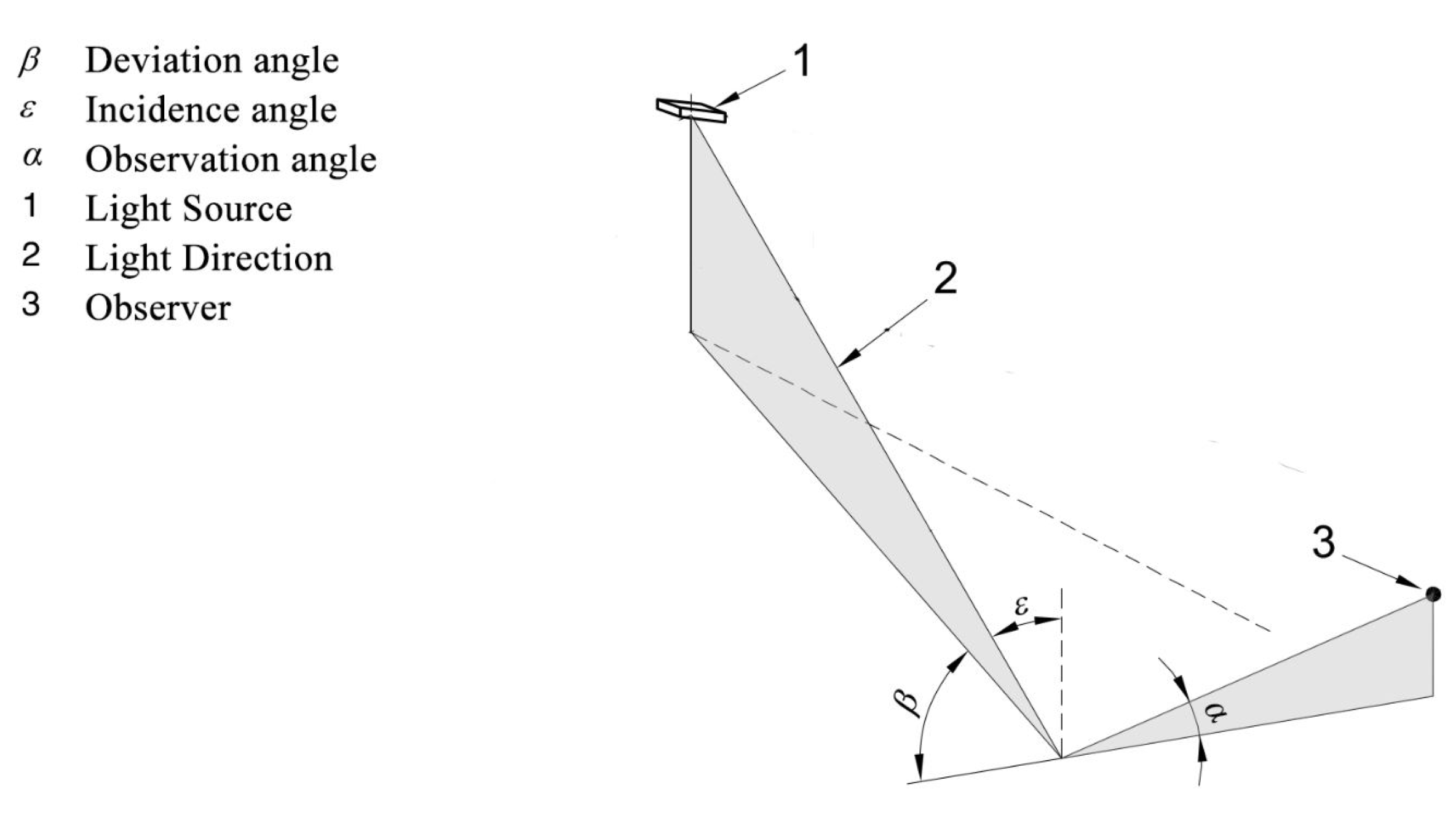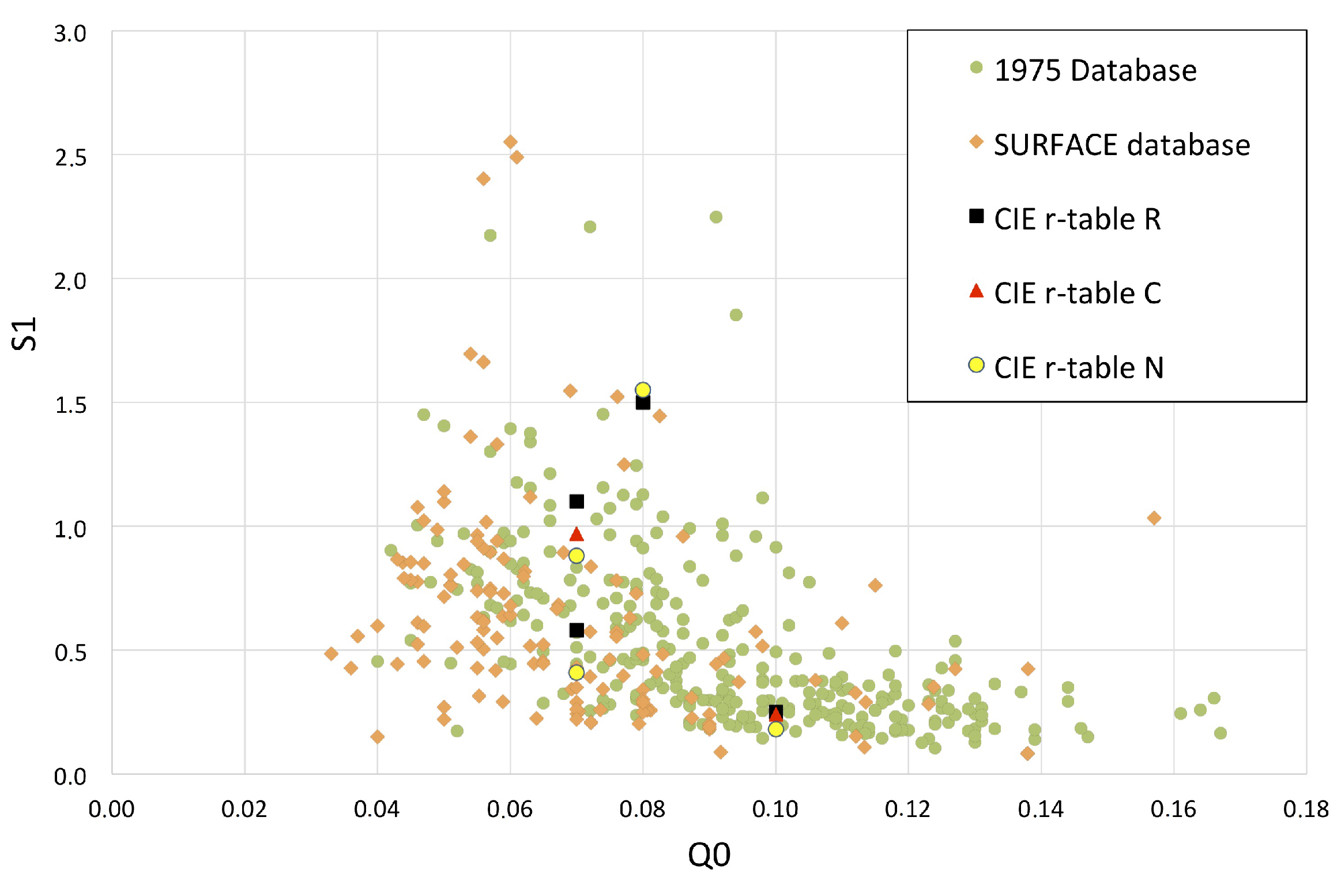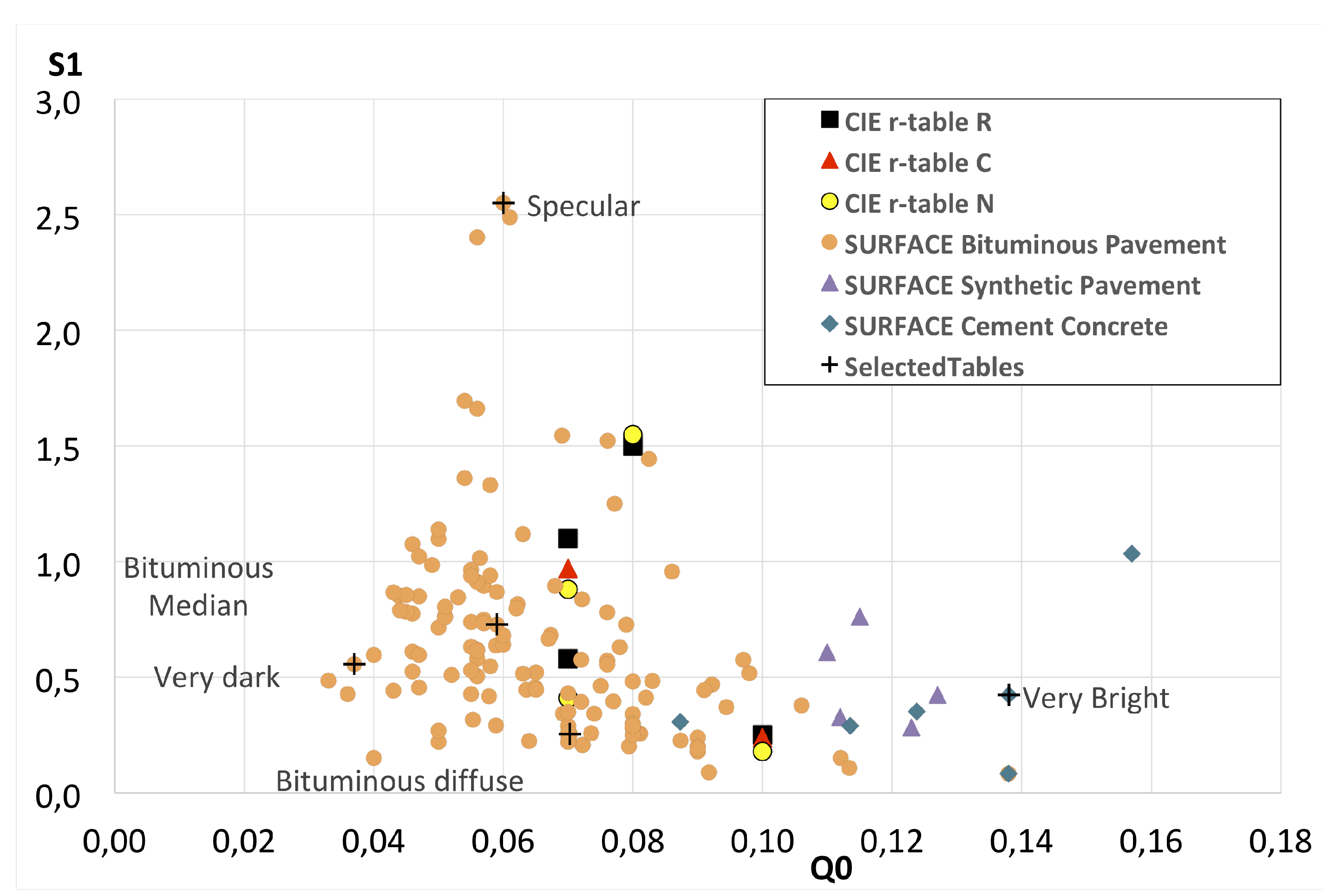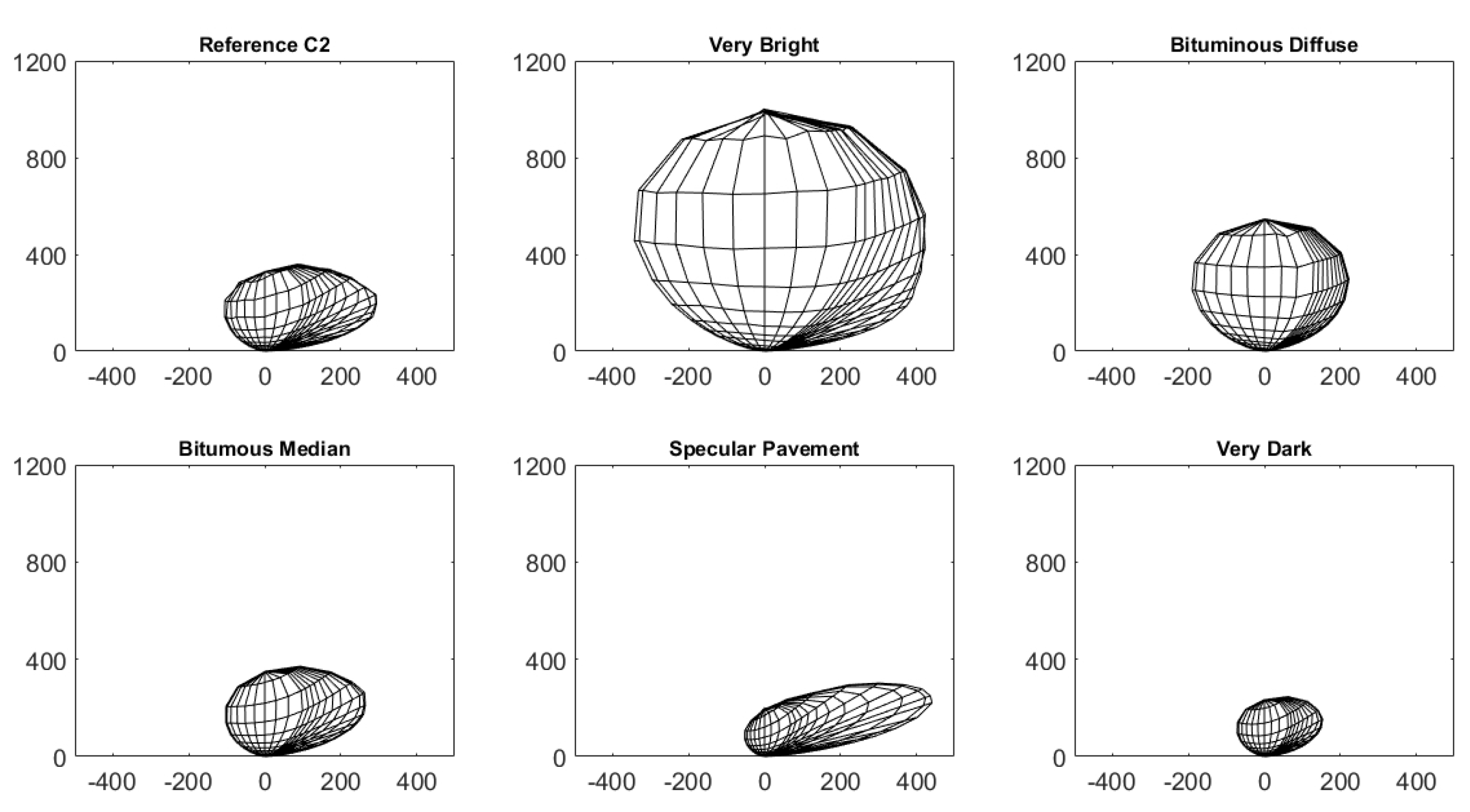Road Surface Photometric Characterisation and Its Impact on Energy Savings
Abstract
:1. Introduction
- The properties of current pavements have progressively changed, and some studies show that using the current standards, based on available CIE data, may lead to errors on average luminance often over 30% and sometimes over 50% [15]. Moreover, the photometric properties of the road materials can change significantly over time [10,16].
- New types of luminaires, especially those using SSL, have very sharp luminous intensity distributions; this simplifies the energy consumption optimisation but increases the influence of the road surface reflective characteristics, especially when luminance and/or uniformities are considered.
- SSL including current LED technology supports smart lighting, and the ability to adapt the flux at any time, in terms of both intensity and direction, according to the brightness requirements and specifics of the road pavement.
2. Materials and Methods
2.1. The Road Luminance Coefficient
- q is the luminance coefficient measured in [];
- L is the luminance measured in [];
- E is the illuminance measured in [].
- is the calculated averaged maintained road luminance [];
- is the calculated averaged maintained road illuminance [];
- is the average luminance coefficient of the selected road adopted in calculation during the road lighting design.
- At the analysis stage, e.g., through the classification of the luminaires in standardised environments,
- At the synthesis, allowing the design of lighting installations with predictable energy savings,
- At the final on-site verification stage, the agreement with prescriptions based on permits to easily declare the compliance with the standards and energy savings
2.2. Energy Performance Indicators
- P is the total system power, in [], of the lighting installation calculated as sum of the operational power of every lighting point () and of the operational power () of all devices necessary for the operation of the lighting system : ;
- A is the lit relevant area in [];
- is the maintained average horizontal illuminance, in [], of the sub-area .
- is the total system power, in [], of the lighting installation in the j-th period of time;
- A is the lit relevant area (in []);
- is the period of time when the power is consumed and is measured in [].
2.3. Design and Calculation of the Road Luminance Values
- is the luminance coefficient of the road surface [7] measured in reciprocal steradians;
- is the luminance of the road surface as viewed in the direction ;
- is the illuminance on the lighted elementary road surface considering the incident light path with angular coordinates . Standards [20] consider the angle of observation of the road surface , constant and sets = 1.
- L is the luminance at the point on the road;
- is the normalized luminous intensity of the luminaire at a direction specified by the angular coordinates , in [];
- is the luminance coefficient for the incident light path with angular coordinates ;
- is the luminous flux of the luminaire, in [];
- is the luminaire overall maintenance factor, unit 1;
- H is the mounting height of the luminaire above the surface of the road, in [].
- the manufacturing tolerances of a luminaire are generally given considering the rated luminous flux and a nominal luminous intensity distribution;
- luminaires with flux control can work at the rated luminous flux while their luminous intensity distribution may change with aging;
- it helps to identify photometric contribution (luminous flux) and geometric contribution (direction of lighting) that depend on mounting tolerances (mounting height of the luminaire, inter-distance between poles, rotation, orientation and tilt of the luminaire);
- tolerances on the luminaire luminous flux and on the luminous intensity distribution may arise from different physical causes: for example, in traditional luminaires, the luminous flux of the source and the source position with respect to the reflector focus, or in LED luminaires, the total luminous flux and the ratio between the luminous flux of the single chips or the mechanical position of the LED module;
- luminaire aging may independently modify the luminous flux value and the normalized luminous intensity distribution.
2.4. SURFACE Project and Its New Data Collection
- 40 r-tables from Switzerland;
- 182 r-tables from France;
- 18 and factors from Finland.
2.5. Road Lighting Design Comparison
- Selection of a CIE r-table among the CIE r-tables database;
- Selection of different r-tables among the SURFACE r-tables database;
- Selection of a road category and structural parameters;
- Design of a road lighting system:
- Case A: With pole distance optimized for the selected CIE r-table;
- Case B: With pole distance optimized for each r-table.
2.5.1. Step 1
- In Switzerland, the most used table is R3. They sometimes measure and then scale the R3 table;
- In Italy, C2 is used with = 0.07 in roads and C2 with = 0.056 in tunnels;
- In France R2 or R3 are generally used and there is no scaling according to ;
- In England, C1 and C2 are used;
- In the Nordic countries, N2 is used with = 0.08 or N1 with = 0.1 Wet tables W2 or W3 are also used.
2.5.2. Step 2
- very light and diffusive road surface behaviour, like for example cement or synthetic pavements,
- the median of the values representative of current bituminous roads,
- very specular road surface behaviour, like a specular bituminous pavement,
- very dark bituminous pavement.
2.5.3. Step 3
2.5.4. Step 4
- Design of a road lighting system using CIE reference table of the selected road (Table 2): the pole distance and luminaire set-up are optimized for C2 road surface. Then in the actual situation the road surface can be very different from the selected C2. Case A;
- Design of a brand-new system for a known actual road surface behavior (Table 2): the position of the poles and luminaire set-up are optimized for the given road surface behavior. Case B.
3. Results
- V can be either L, or quantity of C2 reference of the road surface under test.
- , power density indicator, ratio between the system power of the lighting installation over the mean illuminance on the reference area. Because in Case B the pole distance is optimized for the different road surfaces, reference area is weighted for the number of poles installed in 1 of the road of Table 3.
4. Discussion
5. Conclusions
Author Contributions
Funding
Acknowledgments
Conflicts of Interest
Abbreviations
| CEN | European Standard Organization |
| CIE | Commission International de l’Eclairage |
| EMPIR | European Metrology Programme for Innovation and Research |
| EURAMET | European Association of National Metrology Institutes |
| EU | European Community |
| LED | Light Emitting Diode |
| NMI | National Metrology Institute |
| SSL | Solid-State Lighting |
| UNI | Ente Italiano Normazione |
References
- Road Statistics. Yearbook 2017 Road Statistics; European Union Road Federation: Brussels, Belgium, 2017; Available online: http://www.erf.be/wp-content/uploads/2018/01/Road_statistics_2017.pdf (accessed on 28 March 2019).
- CIE144:2001. Road Surface and Road Marking Reflection Characteristics; Technical Report; CIE: Wien, Austria, January 2001. [Google Scholar]
- EN 13201-2:2015. Part 2: Performance requirements. In Road Lighting; CEN: Bruxelles, Belgium, 2015. [Google Scholar]
- EN 13201-5:2015. Part 5: Energy performance indicators. In Road Lighting; CEN: Bruxelles, Belgium, 2015. [Google Scholar]
- CIE115:2010. Lighting of Roads for Motor and Pedestrian Traffic; Technical Report; CIE: Wien, Austria, March 2010. [Google Scholar]
- EN 13201-1:2015. Part 1: Selection of road classes. In Road Lighting; CEN: Bruxelles, Belgium, 2015. [Google Scholar]
- CIE 17:2011. International Lighting Vocabulary; Technical Report; CIE: Wien, Austria, July 2011. [Google Scholar]
- Muzet, V.; Abdo, J. On site photometric characterisation of cement concrete pavements with Coluroute device. Light Eng. 2018, 26, 88–94. [Google Scholar]
- Ylinen, A.; Pellinen, T.; Valtonen, J.; Puolakka, M.; Halonen, L. Investigation of pavement light reflection characteristics. Road Mater. Pavement Des. 2011, 12, 587–614. [Google Scholar] [CrossRef]
- Dumont, E.; Paumier, J. Are standard tables R still representative of the properties of road surfaces in France? In The CIE 26th Session, Beijing, China, 4–11 July 2007; The International Commission on Illumination: Wien, Austria, 2007. [Google Scholar]
- Jackett, M.; Frith, W. Reflection properties of New Zealand road surfaces for road lighting design. In IPENZ Transportation Group Conference, Christchurch, NZ, USA, 14–17 March 2010; Transportation Group: Christchurch, NZ, USA, 2010. [Google Scholar]
- Petrinska, I.; Ivanov, D.; Pavlov, D.; Nikolova, K. Road Surface Reflection Properties of Typical for Bulgaria Pavement Materials. In Proceedings of the Lux Junior, Dörnfeld, Germany, 25–27 September 2015. [Google Scholar]
- Ylinen, A.; Puolakka, M.; Halonen, L. Road surface reflection properties and applicability of the r-tables for today’s pavement materials in Finland. Light Eng. 2010, 18, 78–90. [Google Scholar]
- GREEN PAPER. Lighting the Future Accelerating the deployment of innovative lighting technologies. Available online: https://eur-lex.europa.eu/legal-content/GA/TXT/?uri=CELEX:52011DC0889 (accessed on 28 March 2019).
- Chain, C.; Lopez, F.V.P. Impact of real road photometry on public lighting design. In The CIE 26th Session, Beijing, China, 4–11 July 2007; The International Commission on Illumination: Wien, Austria, 2007. [Google Scholar]
- Muzet, V.; Greffier, F.; Nicolaï, A.; Taron, A.; Verny, P. Evaluation of the performance of an optimized road surface/lighting combination. Lighting Res.Technol. 2018. [Google Scholar] [CrossRef]
- Surface Pavement Surface characterisation for smart and efficient road lighting. Available online: https://surface-nrm02.eu (accessed on 28 March 2019).
- Fotios, S.; Boyce, P.; Ellis, C. The effect of pavement material on road lighting performance. Light. J. Rugby 2006, 71, 35. [Google Scholar]
- EN 13201-4:2015. Part 4: Verification of performance. In Road Lighting; CEN: Bruxelles, Belgium, 2015. [Google Scholar]
- EN 13201-3:2015. Part 3: Calculation of performance. In Road Lighting; CEN: Bruxelles, Belgium, 2015. [Google Scholar]
- Euramet. The European Association of National Metrology Institutes. Available online: https://www.euramet.org/about-euramet/ (accessed on 28 March 2019).
- Road Surface workshop at CIE Mid Term Session, 25 October 2017, Jeju, Korea. Available online: https://surface-nrm02.eu/publications-presentations/ (accessed on 28 March 2019).
- CIE Expert Symposium A New Vision of Visibility in Roadway Lighting, 25–26 May 2018, Berlin, Germany. Available online: https://surface-nrm02.eu/publications-presentations/ (accessed on 28 March 2019).
- Sörensen, K. Report 10. In Road Surface Reflection Data; The Danish Illuminating Engineering Laboratory: Lyngby, Denmark, 1975. [Google Scholar]
- ISO CIE TS 22012:2019. Light and Lighting—Maintenance Factor Determination—Way of Working; Standard, International Organization for Standardization: Geneva, Switzerland, 2019. [Google Scholar]
- Rossi, G.; Iacomussi, P.; Zinzi, M. Lighting Implications of Urban Mitigation Strategies through Cool Pavements: Energy Savings and Visual Comfort. Climate 2018, 6, 26. [Google Scholar] [CrossRef]
- Commission, E. Accelerating the Deployment of Innovative Lighting in European Cities. In Lighting the Cities; Publications Office of the European Union: Bruxelles, Belgium, 2013; p. 44. [Google Scholar] [CrossRef]




| Table Family | Standard Table | Country of Adoption | ||
|---|---|---|---|---|
| R | R1 | 0.1 | 0.25 | |
| R2 | 0.07 | 0.58 | France | |
| R3 | 0.07 | 1.1 | Switzerland, France | |
| R4 | 0.08 | 1.5 | ||
| N | N1 | 0.1 | 0.18 | Nordic countries |
| N2 | 0.07 | 0.41 | Nordic countries with = 0.08 | |
| N3 | 0.07 | 0.88 | ||
| N4 | 0.08 | 1.55 | ||
| C | C1 | 0.1 | 0.24 | England |
| C2 | 0.07 | 0.97 | England, Italy ( = 0.07 in roads and 0.056 in tunnels) |
| Road Surface Type | Relevant Photometric Parameters | ||
|---|---|---|---|
| Database | Description | ||
| CIE | Reference C2 | 0.070 | 0.970 |
| SURFACE | Very Bright | 0.138 | 0.410 |
| Bituminous Diffuse | 0.070 | 0.253 | |
| Bituminous Median | 0.059 | 0.730 | |
| Specular | 0.060 | 2.550 | |
| Very Dark | 0.037 | 0.560 | |
| Road Dimension Profile | Normative Requirements as in EN 13201-2 | ||||
|---|---|---|---|---|---|
| Width [] | No. of Lanes - | L [] | [-] | [-] | [%] |
| 7 | 2 | >1 | >0.4 | >0.6 | <15 |
| Parameter | Value |
|---|---|
| Lighting class | M3 |
| Luminous Intensity class | G3 |
| Glare Index class | D.5 |
| Pole height | 10 |
| Source height | 9.87 |
| Pole arrangement | single side |
| Pole road side distance | 2 |
| Luminous flux (light source) | 13,245 |
| Luminous flux (luminaire) | 12,185 |
| Luminous intensity (luminaire) | at 70°: 677 |
| at 80°: 27 | |
| at 90°: 5.08 |
| Parameter | Value |
|---|---|
| Power of the luminaire | 79 |
| Pole distance | 44 |
| Luminaire tilt | 5° |
| Arm length | 2 |
| Road Surface Type | Power of the Luminaire [W] | Pole Distance [m] | Arm Length [m] | Luminaire Tilt |
|---|---|---|---|---|
| Reference C2 | 79 | 44 | 2 | 5° |
| Very Bright | 59 | 45 | 1 | 0° |
| Bituminous Diffuse | 79 | 44 | 1 | 0° |
| Bituminous Median | 86 | 45 | 2 | 0° |
| Specular | 79 | 36 | 1 | 5° |
| Very Dark | 112 | 35 | 1 | 0° |
| Road Surface Type | L [] | U0 [-] | Ul [-] | fTI [%] | E mean [lx] | Poles Per Kilometre [-] |
|---|---|---|---|---|---|---|
| Normative requirements | >1 | >0.4 | >0.6 | <15 | - | - |
| Reference C2 | 1.01 | 0.60 | 0.64 | 13 | 14 | 23 |
| Very Bright | 2.06 | 0.62 | 0.63 | 7 | 14 | 23 |
| Bituminous Diffuse | 1.05 | 0.71 | 0.52 * | 13 | 14 | 23 |
| Bituminous Median | 0.91 * | 0.62 | 0.64 | 14 | 14 | 23 |
| Specular | 0.96 * | 0.38 * | 0.32 * | 14 | 14 | 23 |
| Very Dark | 0.57 * | 0.69 | 0.67 | 20 * | 14 | 23 |
| Road Surface Type | L [] | U0 [-] | Ul [-] | fTI [%] | E mean [lx] | Poles Per Kilometre [-] |
|---|---|---|---|---|---|---|
| Normative requirements | >1 | >0.4 | >0.6 | <15 | - | - |
| Reference C2 | 1.01 | 0.60 | 0.64 | 13 | 14 | 23 |
| Very Bright | 1.07 | 0.68 | 0.60 | 6 | 8 | 22 |
| Bituminous Diffuse | 1.06 | 0.72 | 0.60 | 14 | 15 | 23 |
| Bituminous Median | 1.00 | 0.61 | 0.60 | 15 | 16 | 22 |
| Specular | 1.04 | 0.43 | 0.60 | 13 | 17 | 28 |
| Very Dark | 1.00 | 0.67 | 0.61 | 6 | 31 | 29 |
| Road Surface Type | [%] | [%] | [%] |
|---|---|---|---|
| Very Bright | 104 | 3.3 | −1.6 |
| Bituminous Diffuse | 4 | 18.3 | −18.8 |
| Bituminous Median | −9.9 | 3.3 | 0 |
| Specular | −5 | −36.7 | −50 |
| Very Dark | −43.6 | 15 | 4.7 |
| Road Surface Type | Luminaire Luminous Flux [lm] | Luminaire Power [W] | L [] | U0 [-] | U1 [-] | fTI [%] | E mean [lx] |
|---|---|---|---|---|---|---|---|
| Reference C2 | 12,064 | 78.2 | 1.00 | 0.60 | 0.64 | 13 | 13.9 |
| Very Bright | 5915 | 38.3 | 1.00 | 0.62 | 0.63 | 6 | 6.8 |
| Bituminous Diffuse | 11,605 | 75.2 | 1.00 | 0.71 | 0.52 | 13 | 13.3 |
| Bituminous Median | 13,390 | 86.8 | 1.00 | 0.62 | 0.64 | 14 | 15.4 |
| Specular | 12,693 | 82.3 | 1.00 | 0.38* | 0.32 | 14 | 14.6 |
| Very Dark | 21,377 | 138.6 | 1.00 | 0.69 | 0.67 | 22 | 24.6 |
| Road Surface Type | [-] | Power Density Indicator [] | Annual Energy Consumption Indicator [] | Difference on vs. C2 [%] |
|---|---|---|---|---|
| Reference C2 | 1.03 | 18 | 1016 | - |
| Very Bright | 2.1 | 18 | 498 | −51 |
| Bituminous Diffuse | 1.07 | 18 | 977 | −3.8 |
| Bituminous Median | 0.92 | 18 | 1127 | 11 |
| Specular | 0.98 | 18 | 1069 | 5.2 |
| Very Dark | 0.58 | 18 | 1800 | 77.2 |
| Road Surface Type | [-] | Power Density Indicator [] | Annual Energy Consumption Indicator [] | Difference on vs. C2 [%] |
|---|---|---|---|---|
| Reference C2 | 1.03 | 18 | 1016 | - |
| Very Bright | 0.98 | 24 | 749 | −27 |
| Bituminous Diffuse | 1.01 | 17 | 1026 | 0 |
| Bituminous Median | 1.06 | 17 | 1092 | 6.4 |
| Specular | 1.02 | 18 | 1254 | 22.2 |
| Very Dark | 0.87 | 15 | 1829 | 78.2 |
© 2019 by the authors. Licensee MDPI, Basel, Switzerland. This article is an open access article distributed under the terms and conditions of the Creative Commons Attribution (CC BY) license (http://creativecommons.org/licenses/by/4.0/).
Share and Cite
Gidlund, H.; Lindgren, M.; Muzet, V.; Rossi, G.; Iacomussi, P. Road Surface Photometric Characterisation and Its Impact on Energy Savings. Coatings 2019, 9, 286. https://doi.org/10.3390/coatings9050286
Gidlund H, Lindgren M, Muzet V, Rossi G, Iacomussi P. Road Surface Photometric Characterisation and Its Impact on Energy Savings. Coatings. 2019; 9(5):286. https://doi.org/10.3390/coatings9050286
Chicago/Turabian StyleGidlund, Henrik, Mikael Lindgren, Valerie Muzet, Giuseppe Rossi, and Paola Iacomussi. 2019. "Road Surface Photometric Characterisation and Its Impact on Energy Savings" Coatings 9, no. 5: 286. https://doi.org/10.3390/coatings9050286
APA StyleGidlund, H., Lindgren, M., Muzet, V., Rossi, G., & Iacomussi, P. (2019). Road Surface Photometric Characterisation and Its Impact on Energy Savings. Coatings, 9(5), 286. https://doi.org/10.3390/coatings9050286





